Page 584 of 685
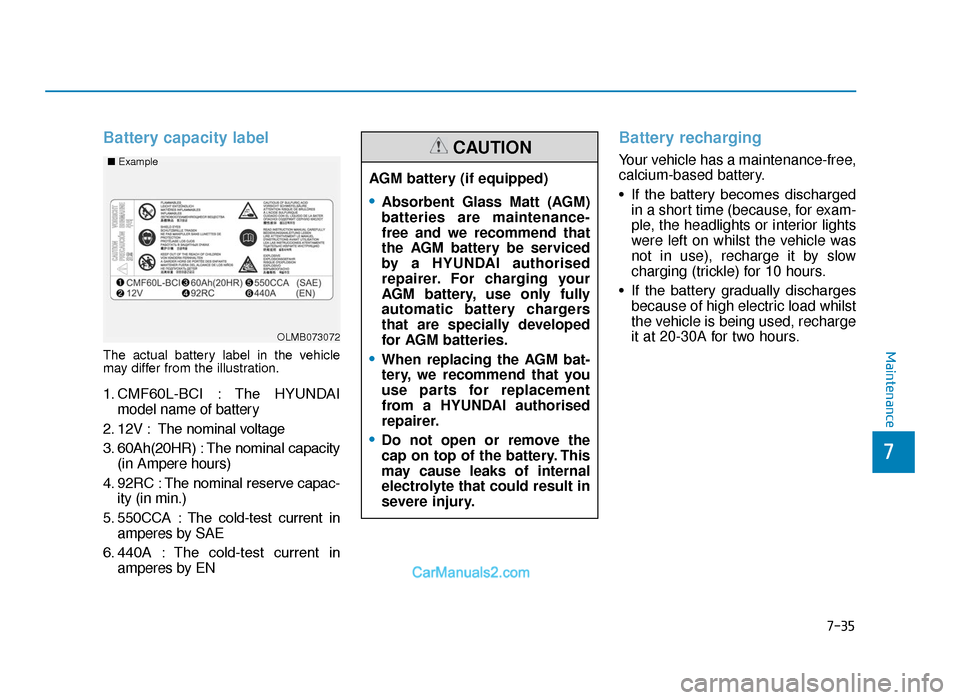
7-35
7
Maintenance
Battery capacity label
The actual battery label in the vehicle
may differ from the illustration.
1. CMF60L-BCI : The HYUNDAImodel name of battery
2. 12V : The nominal voltage
3. 60Ah(20HR) : The nominal capacity (in Ampere hours)
4. 92RC : The nominal reserve capac- ity (in min.)
5. 550CCA : The cold-test current in amperes by SAE
6. 440A : The cold-test current in amperes by EN
Battery recharging
Your vehicle has a maintenance-free,
calcium-based battery.
• If the battery becomes dischargedin a short time (because, for exam-
ple, the headlights or interior lights
were left on whilst the vehicle was
not in use), recharge it by slow
charging (trickle) for 10 hours.
• If the battery gradually discharges because of high electric load whilst
the vehicle is being used, recharge
it at 20-30A for two hours.
OLMB073072
■
Example
AGM battery (if equipped)
•Absorbent Glass Matt (AGM)
batteries are maintenance-
free and we recommend that
the AGM battery be serviced
by a HYUNDAI authorised
repairer. For charging your
AGM battery, use only fully
automatic battery chargers
that are specially developed
for AGM batteries.
•When replacing the AGM bat-
tery, we recommend that you
use parts for replacement
from a HYUNDAI authorised
repairer.
•Do not open or remove the
cap on top of the battery. This
may cause leaks of internal
electrolyte that could result in
severe injury.
CAUTION
TLe UK 7.qxp 5/10/2018 1:34 PM Page 35
Page 594 of 685
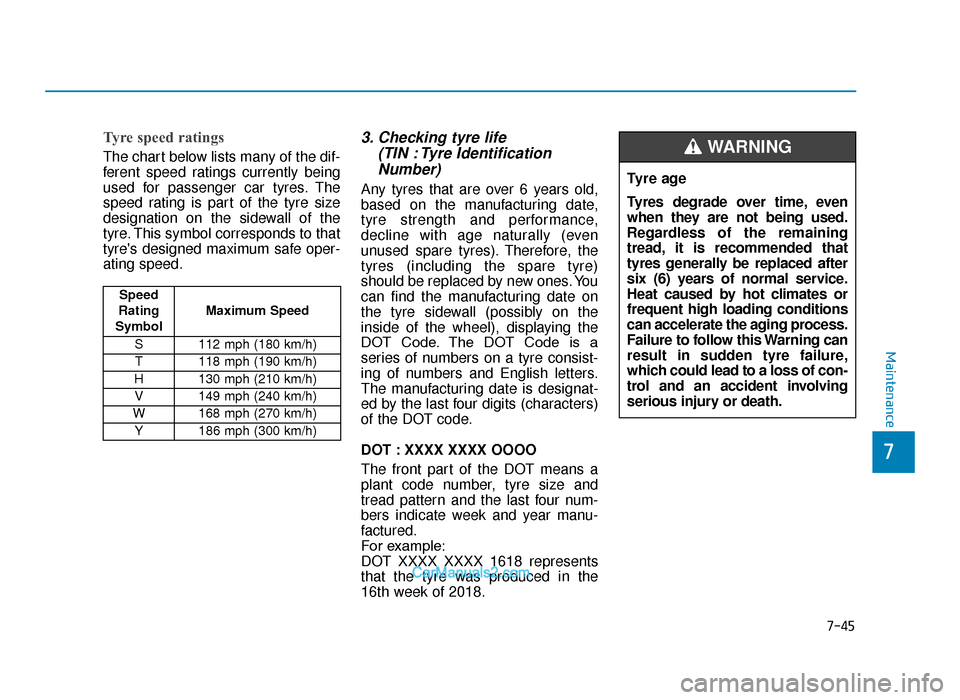
7-45
7
Maintenance
Tyre speed ratings
The chart below lists many of the dif-
ferent speed ratings currently being
used for passenger car tyres. The
speed rating is part of the tyre size
designation on the sidewall of the
tyre. This symbol corresponds to that
tyre's designed maximum safe oper-
ating speed.
3. Checking tyre life (TIN : Tyre IdentificationNumber)
Any tyres that are over 6 years old,
based on the manufacturing date,
tyre strength and performance,
decline with age naturally (even
unused spare tyres). Therefore, the
tyres (including the spare tyre)
should be replaced by new ones. You
can find the manufacturing date on
the tyre sidewall (possibly on the
inside of the wheel), displaying the
DOT Code. The DOT Code is a
series of numbers on a tyre consist-
ing of numbers and English letters.
The manufacturing date is designat-
ed by the last four digits (characters)
of the DOT code.
DOT : XXXX XXXX OOOO
The front part of the DOT means a
plant code number, tyre size and
tread pattern and the last four num-
bers indicate week and year manu-
factured.
For example:
DOT XXXX XXXX 1618 represents
that the tyre was produced in the
16th week of 2018. Tyre age
Tyres degrade over time, even
when they are not being used.
Regardless of the remaining
tread, it is recommended that
tyres generally be replaced after
six (6) years of normal service.
Heat caused by hot climates or
frequent high loading conditions
can accelerate the aging process.
Failure to follow this Warning can
result in sudden tyre failure,
which could lead to a loss of con-
trol and an accident involving
serious injury or death.
WARNING
Speed
Rating
Symbol Maximum Speed
S 112 mph (180 km/h) T 118 mph (190 km/h)
H 130 mph (210 km/h) V 149 mph (240 km/h)
W 168 mph (270 km/h)
Y186 mph (300 km/h)
TLe UK 7.qxp 5/10/2018 1:35 PM Page 45
Page 595 of 685
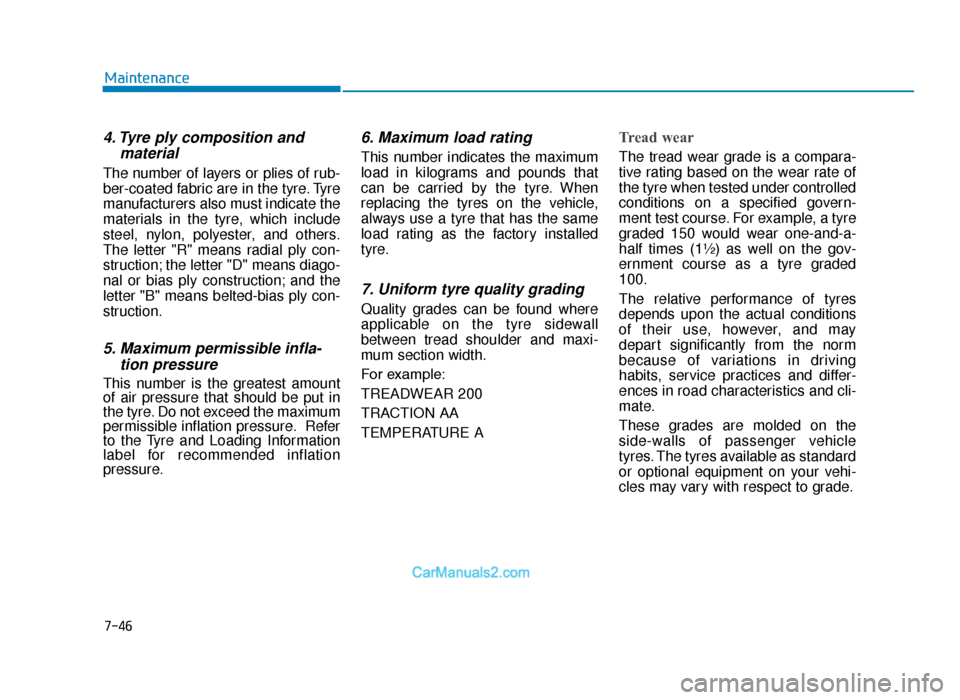
7-46
Maintenance
4. Tyre ply composition andmaterial
The number of layers or plies of rub-
ber-coated fabric are in the tyre. Tyre
manufacturers also must indicate the
materials in the tyre, which include
steel, nylon, polyester, and others.
The letter "R" means radial ply con-
struction; the letter "D" means diago-
nal or bias ply construction; and the
letter "B" means belted-bias ply con-
struction.
5. Maximum permissible infla-tion pressure
This number is the greatest amount
of air pressure that should be put in
the tyre. Do not exceed the maximum
permissible inflation pressure. Refer
to the Tyre and Loading Information
label for recommended inflation
pressure.
6. Maximum load rating
This number indicates the maximum
load in kilograms and pounds that
can be carried by the tyre. When
replacing the tyres on the vehicle,
always use a tyre that has the same
load rating as the factory installed
tyre.
7. Uniform tyre quality grading
Quality grades can be found where
applicable on the tyre sidewall
between tread shoulder and maxi-
mum section width.
For example:
TREADWEAR 200
TRACTION AA
TEMPERATURE A
Tread wear
The tread wear grade is a compara-
tive rating based on the wear rate of
the tyre when tested under controlled
conditions on a specified govern-
ment test course. For example, a tyre
graded 150 would wear one-and-a-
half times (1½) as well on the gov-
ernment course as a tyre graded
100.
The relative performance of tyres
depends upon the actual conditions
of their use, however, and may
depart significantly from the norm
because of variations in driving
habits, service practices and differ-
ences in road characteristics and cli-
mate.
These grades are molded on the
side-walls of passenger vehicle
tyres. The tyres available as standard
or optional equipment on your vehi-
cles may vary with respect to grade.
TLe UK 7.qxp 5/10/2018 1:35 PM Page 46
Page 628 of 685
7-79
7
Maintenance
Inside lamp
Tail lamp/Back-up lamp
1. Turn off the engine.
2. Open the tailgate.
3. Remove the service cover using aflat-blade screwdriver. 4. Remove the socket from the
assembly by turning the socket
counterclockwise until the tabs on
the socket align with the slots on
the assembly.
5. Pull the bulb out of the socket.
6. Insert a new bulb into the socket.
7. Install the socket into the assem- bly by aligning the tabs on the
socket with the slots on the
assembly and turning the socket
clockwise.
8. Reinstall the lamp assembly to the body of the vehicle
Tail lamp, Rear fog lamp
(Type B, LED)
If the LED lamp does not operate, we
recommend you to have the vehicle
checked by a HYUNDAI authorised
repairer.
OTLE075016
OTL075039
TLe UK 7.qxp 5/10/2018 1:39 PM Page 79
Page 652 of 685
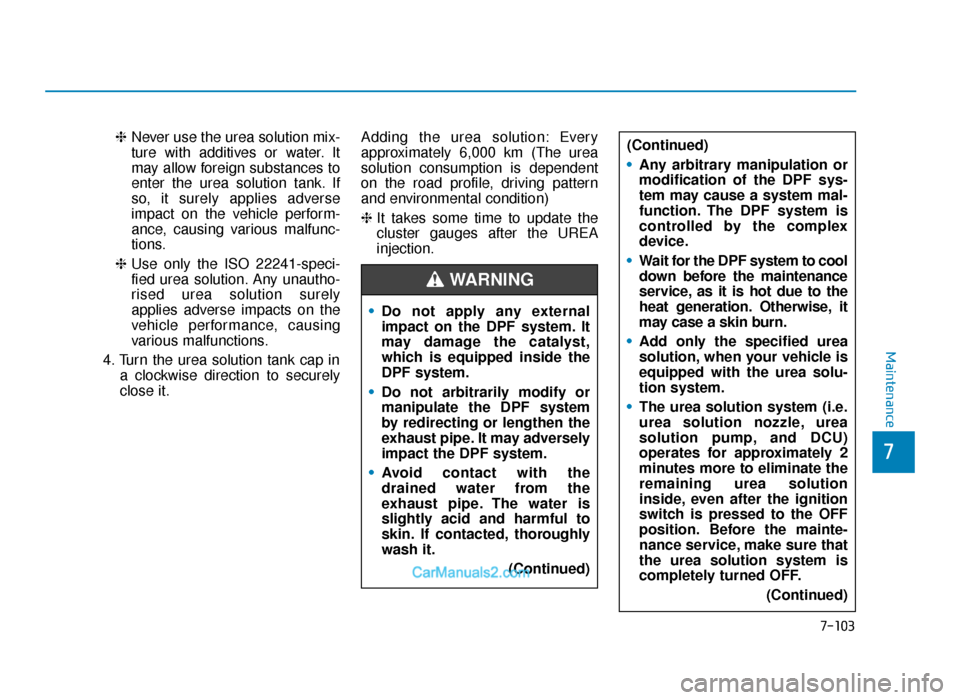
❈Never use the urea solution mix-
ture with additives or water. It
may allow foreign substances to
enter the urea solution tank. If
so, it surely applies adverse
impact on the vehicle perform-
ance, causing various malfunc-
tions.
❈ Use only the ISO 22241-speci-
fied urea solution. Any unautho-
rised urea solution surely
applies adverse impacts on the
vehicle performance, causing
various malfunctions.
4. Turn the urea solution tank cap in a clockwise direction to securely
close it. Adding the urea solution: Every
approximately 6,000 km (The urea
solution consumption is dependent
on the road profile, driving pattern
and environmental condition)
❈
It takes some time to update the
cluster gauges after the UREA
injection.
7-103
7
Maintenance
•Do not apply any external
impact on the DPF system. It
may damage the catalyst,
which is equipped inside the
DPF system.
• Do not arbitrarily modify or
manipulate the DPF system
by redirecting or lengthen the
exhaust pipe. It may adversely
impact the DPF system.
• Avoid contact with the
drained water from the
exhaust pipe. The water is
slightly acid and harmful to
skin. If contacted, thoroughly
wash it.
(Continued)
WARNING
(Continued)
•Any arbitrary manipulation or
modification of the DPF sys-
tem may cause a system mal-
function. The DPF system is
controlled by the complex
device.
• Wait for the DPF system to cool
down before the maintenance
service, as it is hot due to the
heat generation. Otherwise, it
may case a skin burn.
• Add only the specified urea
solution, when your vehicle is
equipped with the urea solu-
tion system.
• The urea solution system (i.e.
urea solution nozzle, urea
solution pump, and DCU)
operates for approximately 2
minutes more to eliminate the
remaining urea solution
inside, even after the ignition
switch is pressed to the OFF
position. Before the mainte-
nance service, make sure that
the urea solution system is
completely turned OFF.
(Continued)
TLe UK 7.qxp 6/12/2018 2:51 PM Page 103
Page 656 of 685
7-107
7
Maintenance
•If defective urea solution or
liquid that is not recommend-
ed is supplied, there may be
damage on the parts of the
vehicle such as processing
device. If defective fuel is
used, foreign objects will be
accumulated to SCR catalyst
and cause catalyst pushed
away or breaking.
After adding the incorrect
urea solution, please visit the
closest service centre as early
as possible.
•Liquid that are not recom-
mended such as diesel,
petrol, and alcohol shall never
be used other than the recom-
mended urea solution that
satisfy ISO22241 or DIN70070.
CAUTION
TLe UK 7.qxp 6/12/2018 2:51 PM Page 107
Page 667 of 685
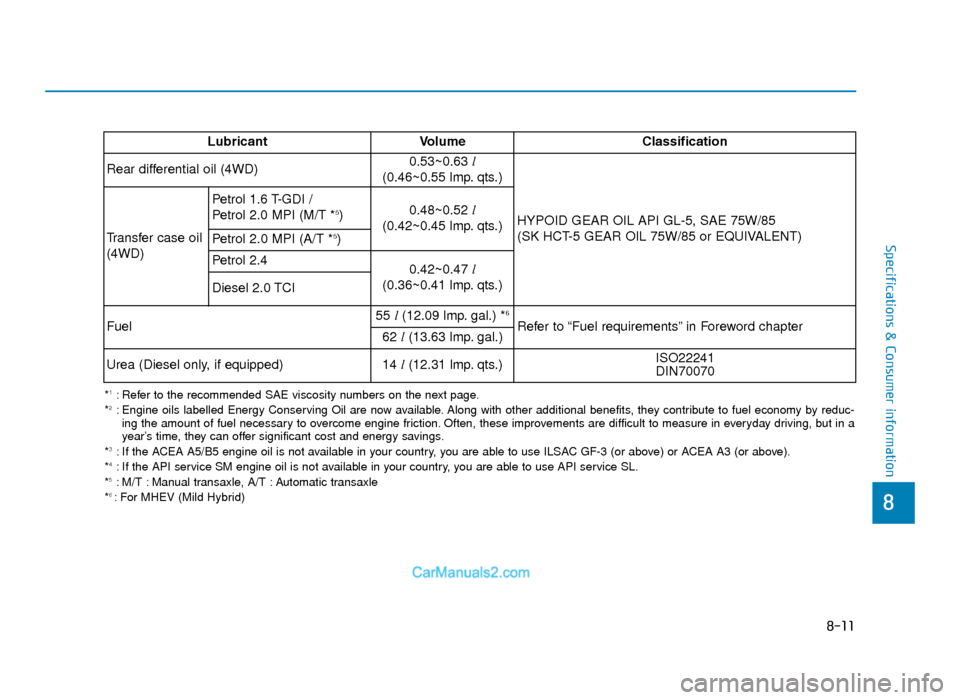
8-11
8
Specifications & Consumer information
LubricantVolume Classification
Rear differential oil (4WD) 0.53~0.63
l
(0.46~0.55 lmp. qts.)
HYPOID GEAR OIL API GL-5, SAE 75W/85
(SK HCT-5 GEAR OIL 75W/85 or EQUIVALENT)
Transfer case oil
(4WD) Petrol 1.6 T-GDI /
Petrol 2.0 MPI (M/T *
5)
0.48~0.52
l
(0.42~0.45 lmp. qts.)
Petrol 2.0 MPI (A/T *
5)
Petrol 2.4 0.42~0.47l
(0.36~0.41 lmp. qts.)
Diesel 2.0 TCI
Fuel 55
l(12.09 lmp. gal.) *
6
Refer to “Fuel requirements” in Foreword chapter
62 l(13.63 lmp. gal.)
Urea (Diesel only, if equipped) 14
l(12.31 lmp. qts.) ISO22241
DIN70070
*1: Refer to the recommended SAE viscosity numbers on the next page.
*2: Engine oils labelled Energy Conserving Oil are now available. Along with other additional benefits, they contribute to fuel economy by reduc- ing the amount of fuel necessary to overcome engine friction. Often, these improvements are difficult to measure in everyday driving, but in ayear’s time, they can offer significant cost and energy savings.
*
3: If the ACEA A5/B5 engine oil is not available in your country, you are able to use ILSAC GF-3 (or above) or ACEA A3 (or above) .
*4: If the API service SM engine oil is not available in your country, you are able to use API service SL.
*5: M/T : Manual transaxle, A/T : Automatic transaxle
*6 : For MHEV (Mild Hybrid)
TLe UK 8.qxp 6/12/2018 3:17 PM Page 11
Page 672 of 685
A compressor label informs you the
type of compressor your vehicle is
equipped with such as model, suppli-
er part number, production number,
refrigerant and refrigerant oil.The refrigerant label provides infor-
mation such as refrigerant type and
amount.
The label is located on the underside
the bonnet.
The radio frequency components of
the vehicle comply with requirements
and other relevant provisions of
Directive 1995/5/EC.
Further information including the
manufacturer's declaration of con-
formity is available on HYUNDAI
web site as follows;
http://service.hyundai-motor.com
REFRIGERANT LABELAIR CONDITIONER
C
OMPRESSOR LABEL
OTLE088010
OTLE088009
CE0678
■
Example
DECLARATION OF
C
ONFORMITY
Specifications & Consumer information
8-16
TLe UK 8.qxp 6/12/2018 3:18 PM Page 16